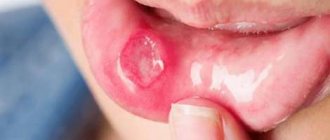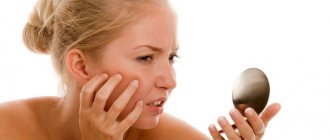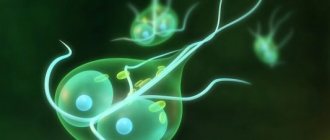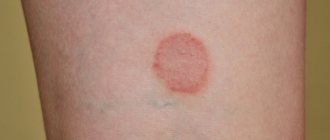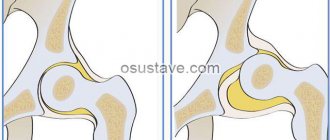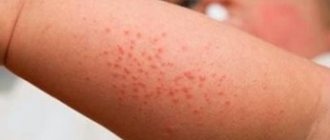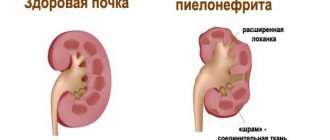Roseola is a viral disease that affects children of different ages; it occurs quite often. Roseola is difficult to diagnose, and its symptoms are similar to other diseases, so it is extremely difficult to determine the presence of roseola. Knowing the causes and symptoms of roseola, you can recognize it and go to the hospital in time. If treatment is not started immediately, the disease will progress. A specialist will help determine your baby’s condition and prescribe appropriate treatment.
General information
The rarely diagnosed but common childhood disease roseola has been known for a long time. Roseola (or as it is sometimes called: sixth disease, pseudorubella, sudden exanthema) is a contact disease caused by the herpes virus types 6 and 7 and transmitted like all childhood infections. Herpes viruses are constantly present in the body of many people - their carriers have at least once discovered a “cold” on their lips in the form of a fluid-filled vesicle. The body coexists quite peacefully with the pathogen, and only during periods of weakened immunity (hypothermia, overheating, fatigue, flight, change of climate or time zone) does it show trouble. This is also true of its groupmate, the virus that causes roseola in children - up to six months the child is not susceptible to this infection, because protected by the mother's antibodies, and after this age, having lost innate immunity, soon falls ill and becomes the owner of lifelong immunity.
The disease is not as well known as other childhood diseases. Suffice it to say that the causative agent of roseola was isolated only in 1986. But this did not stop doctors from ancient times from giving the exact names of the disease - sudden exanthema, infantile roseola, roseola rosea. All these definitions reflect the essence of the disease, which does not pose much harm to the child’s body.
Causes
Roseate rash appears in children after contact with a sick child. The infection spreads through the aerosol route by airborne droplets. The disease becomes contagious when the body temperature rises.
Infection of other babies is likely until it normalizes and another day or so. When a child coughs or sneezes, the roseola virus settles on various objects. These are most often toys, dishes, towels from which infectious particles spread to a healthy baby’s body.
After a viral or microbial particle is transmitted to another person, it multiplies intensively. The appearance of signs of the disease occurs with insufficient immunity. The incubation period is 5-14 days. In some cases, the source of the viral infection is an adult with herpes. The disease has many names:
- pseudorubella;
- three-day fever;
- sudden exanthema;
- sixth disease;
Herpes virus type 6 is widely distributed among adults, but does not manifest itself in the same way as in children. This is due to the formation of type-specific immunity, which persists throughout life. When the disease appears in adults, this type of virus becomes the cause of chronic fatigue syndrome.
Immediately after birth, the newborn receives antibodies from the mother's milk. They protect the child’s body from infection until approximately 9 months of life. Then their level gradually decreases. The baby loses protection against germs and viruses, which increases the body’s susceptibility to disease.
From 9 months to approximately 3 years, rapid symptoms develop. Until about 5 years of age, signs of sudden exanthema in children may be mild. In most babies, roseola occurs in the spring or summer.
Roseola: symptoms and course of the disease in children
How can you tell if your child has roseola? The disease begins immediately, without a prodromal (transition) period, which is inherent in most childhood diseases. At the beginning of the disease there is no rash, characteristic of some other diseases, such as measles.
Against the background of complete well-being, the temperature suddenly rises. The readings on the thermometer are quite frightening: 38 - 40°C. At the same time, deterioration in well-being does not always occur, and if it does, it is often insignificant. The fever is not accompanied by a runny nose, cough, headache or vomiting with diarrhea. From the second day, the child may experience some apathy and lethargy, but this is also not a necessary sign. The condition at high temperatures is quite satisfactory.
The fever lasts an average of 3 days (another name for roseola is three-day fever). Exactly how long this period will last depends on the specific situation. The temperature does not respond well to antipyretics and does not fall below 38°C. Then, over a short period of time, the readings on the thermometer return to normal.
And after a few hours or simultaneously with a drop in temperature, the following symptom appears: a characteristic rash appears on the child’s body (see photo). Small segments of all shades of pink, from 1 to 5 mm in diameter, appear first on the back and buttocks, then on the front of the body, and then on the limbs (not always). Even less often, rashes form on the face. There are cases when the rash first appears on the face and then spreads throughout the body.
The small components of the rash can merge with each other, almost do not rise above the skin, and do not itch. The rash continues for about 1 day. After 1–3 days, the rash disappears without a trace, leaving no marks or peeling.
Roseola - what is it?
This disease usually occurs in childhood and is a viral disease that can be caused by anything. The disease has several names, for example, rubella, three-day fever, exanthemal subitus or sixth disease. Roseola does not affect children under 6 months of age, because the body contains antibodies transmitted from the mother that protect the baby from the virus.
Children most often get sick in the spring or autumn. Roseola begins in the same way as other viral diseases, goes unnoticed as it appears. Symptoms of roseola in children are different, they can be fever, rashes, temperature and other signs that occur with viral diseases. At 4 years old, a child develops antibodies that help protect him from pathogens for the rest of his life.
Many parents do not often hear about this disease. The disease is diagnosed very rarely, since it always begins suddenly, progresses quickly, and its symptoms can be confused and mistaken for a cold.
Roseola is caused by the sixth type of herpes virus HHV-6 and the seventh type HHV-7. The manifestation begins with a fever, after which a red rash appears throughout the body.
The method of transmission of the virus is not fully known, doctors are trying to find the transmitter. However, antibodies are present in every person from birth; anyone can become a carrier. Most scientists are inclined to believe that roseola is transmitted by airborne droplets.
Infection can occur both from an adult who is in contact with a sick person, and from objects examined by an infant: toys, household items, things, etc. The question of whether roseola is contagious has been open for a long time, but most doctors believe that a sick child can still transmit the infection to others. Therefore, it is recommended to protect the patient from children who have not yet had roseola.
The incubation period usually lasts from 3-7 days, in extreme cases up to two weeks.
Subtleties of diagnosis
Defining the disease is difficult because it begins with a fever without rash. This makes it possible to differentiate it from rubella (in a later period), but at the time of diagnosis it does not help much - at this time it is rare that a doctor, much less a parent, will remember roseola. Temperature is an indicator of many diseases.
In most cases, pediatricians take a wait-and-see approach, prescribing symptomatic treatment (which is correct), but some prescribe antibiotics (which in this situation is incorrect, since viruses do not respond to their action). The subsequent appearance of a rash is also often not associated with fever, but is attributed to an allergy or considered a newly discovered disease - rubella.
These features lead to the fact that the diagnosis of roseola in children is made in rare cases.
The rash with rubella is also similar to the rash with roseola, however, with rubella the child’s temperature does not exceed 38 degrees, while with roseola the temperature is always above 38.5-39 degrees. You can read more about rubella in this article.
Symptoms and treatment
The symptoms are very similar to regular rubella or other viral illness. At a young age, it can reach a high temperature, which is very difficult to bring down on your own. Roseola in children allows you to detect the following symptoms; treatment should begin immediately after their detection:
- occurs with temperatures reaching up to 39 degrees, in some cases up to 40 degrees. It is very difficult to bring down the temperature, so it is better to immediately contact a specialist;
- weakness, irritability, insomnia, and lack of appetite also occur;
- a red rash spreads across the body;
- diarrhea appears, redness of the throat, rhinitis, spots on the tongue also become symptoms of roseola.
The rash consists of red spots 5 millimeters thick, convex, creating a white formation around it. The rash appears on the back or stomach. It also gradually appears on other parts of the body. At this time, the baby is more energetic and cheerful, activity comes to him. After 3-4 days, this condition goes away and the baby’s routine returns to normal. In the photo you can see how the rash appears, recognize the disease by consulting a doctor in time. Also, some children may experience seizures - this is also a sign of the disease.
Children get this disease once in their life, after which immunity occurs. Most people get roseola as children, but there have been cases of roseola occurring in adults, but they are extremely rare. By becoming familiar with the signs and symptoms of roseola, a parent can recognize the disease and begin treatment for infant roseola immediately.
The disease occurs in young children, up to 3-4 years of age. A baby under six months old rarely gets sick, as he has protection against the virus. In young children, the disease progresses more easily than in older ones, and faster. In preschool children, roseola occurs in two stages:
- temperature increase;
- the appearance of a rash on the body.
At 3-7 years of age, roseola occurs in one stage, the child only develops an elevated temperature. This stage is not dangerous for the baby. If a rash appears, it goes away within a few hours, or a maximum of one day. The initial stage of treatment for roseola is not difficult.
Children under one year old get sick much more often, but the disease progresses more mildly than in older children. The disease in two stages is really difficult for infants to tolerate. At this time they are impatient, aggressive, capricious. But once the rash goes away, the behavior returns to normal.
In some cases, a complication appears in the form of seizures. However, this condition disappears after five minutes. It is accompanied by screams, falls, freezing, lack of breathing and other similar signs, and the child may not respond to usual questions.
Treatment
Do you need to treat roseola? There are no specific drugs that eliminate infection by the virus. In the vast majority of cases, treatment for the disease is not required: the body itself copes with the pathogenic carrier, stops the spread of the pathogen, producing antibodies to it.
The concern is that in some cases the temperature rises too high. At this time, antipyretics are prescribed. Temperatures above 39°C can trigger seizures in a small child. They do not pose any danger to the child, but they can form an incorrect reaction of the body to any increase in temperature. Therefore, convulsions should not be allowed.
Important! If the temperature does not exceed 38.5°C, there is no need to “bring it down”. This is not a disease, but a response of the body’s immune system to the invasion of the virus.
As with any other illness accompanied by fever, it is necessary to create conditions for a speedy recovery without complications:
- Prevent dehydration and ensure the removal of toxins - constantly give the child something to drink (water, tea, fruit juice, breast milk, etc.), by any means to ensure that fluid enters the body, at least little by little, but constantly;
- Avoid contact with strangers as much as possible - in the first period the disease is very contagious, and for the patient it is dangerous for additional infection - a weakened immune system may miss meeting with other pathogens;
- Do not wrap the child - at elevated temperatures, warm clothes do not improve, but worsen the condition; severe chills mean a sharp rise in temperature, which should not happen with antipyretics;
- Ensure access to clean air - frequently clean (wet!) and ventilate the room; after the temperature drops, walks are possible, because at this time the child is no longer contagious.
Routes of infection
The disease is transmitted by airborne droplets. The patient is especially contagious during the entire period when his body temperature is elevated, and in the first day after its normalization, when the skin begins to become covered with a rash. You can also become infected through the patient's household items - dishes, toys, playpen.
The incubation period of the virus is from 5 to 15 days. If a child has been in contact with a sick person or things that he used, you should closely monitor his health during these days, and if the temperature rises, immediately consult a doctor to rule out roseola.
A few words about antipyretics
In order to improve the child’s well-being and reduce too high a temperature (above 38.5), medications and folk remedies that reduce fever are used.
For some time now, children's medications have been treated with increased attention. This is due to newly discovered details of the effects of certain drugs on the children’s body:
- Analgin, a fairly common remedy used by emergency doctors for mixing with diphenhydramine and administered for fever and pain, is no longer produced almost anywhere except in our country;
- Acetylsalicylic acid, otherwise called aspirin, is strictly contraindicated for children under 12 years of age - the use of the drug is fraught with the development of neurological Raynaud's disease.
The safest drugs are those based on ibuprofen and paracetamol.
It is better to alternate medications to reduce fever (drugs containing paracetamol are alternated with medications containing ibuprofen) if you have to use them more often than prescribed to alleviate the child’s condition.
With a moderate rise in temperature (38.5 - 39°C), you can also use wet wipes (with water, vodka), and drink sour drinks (lingonberries, cranberries, lemon).
Diagnostics
The disease “pseudorubella” is difficult to diagnose due to its rapid progression. As long as doctors prescribe and carry out the necessary tests, the child’s condition can stabilize on its own.
Basic diagnostic methods:
- Analysis of patient complaints (before visiting a doctor, prepare a step-by-step list of symptoms. Their sequence is very important to exclude ARVI, rubella and other viral and allergic diseases)
- External examination of the patient (examination of the rash, its size and location).
- Blood test (indicative for roseola is: a decrease in the level of leukocytes by 4 g/l, an increase in lymphocytes by 40 g/l.
- Serological test of saliva, blood, mother's milk for antibodies to herpes virus types 6 and 7.
- Analysis of stool for worm eggs and dysbacteriosis.
A correct diagnosis allows you to exclude more serious diseases in your baby and protect him from using unnecessary medications.
How to suspect a disease?
The alarm signal is a body temperature of 39–40 °C. At this time, the child becomes sleepy, nervous, anxious, and refuses food. But as a rule, against the background of a very high temperature, the condition of the children is not disturbed. Infants may experience vomiting and seizures. The reason is the migration of the infectious agent in the blood. Fever lasts three days in the classic version. Therefore, one of the synonyms for sudden exanthema is three-day fever.
The main symptom is a maculopapular rash (spots up to 10 mm in diameter, pale pink), which occurs after a few days (3–8 days) of fever. Exanthema, which turns pale when pressed, can persist from hours to several days. It can be seen mainly on the back, stomach, limbs; on the face it is very small or practically absent. Also a sign of infection is an enlargement of all cervical lymph nodes, especially the occipital ones.
Spots appear on almost the entire body: back, stomach, arms, legs and even on the face
Classification and forms
According to its form, roseola can be asymptomatic or develop with corresponding symptoms.
In the first case, the disease poses a danger to others. The child is a source of infection for other children.
In the second case, the intensity of the signs of roseola depends on the individual characteristics of the baby’s body, associated factors and the level of the immune system. Additionally, the infection is divided into two types.
Types of roseola:
- simple form (characterized by the absence of relapse of the disease, develops with characteristic symptoms, including an increase in the child’s body temperature and skin rashes);
- flaky form (a distinctive feature of the disease is a profuse rash consisting of pink spots and blisters).
Complications and consequences
Roseola causes complications only in isolated cases. If you follow doctors' recommendations and timely treatment of the disease, the risk of negative consequences is almost completely eliminated.
If therapy was carried out with violations of the regimen, then under the influence of weakened immunity, additional inflammatory processes may occur.
The virus spreads through the respiratory system and causes dysfunction of individual organs.
Complications of roseola can include the following conditions:
- otitis;
- pneumonia;
- polyneuritis;
- Chronical bronchitis;
- encephalitis;
- meningitis;
- intussusception;
- meningoencephalitis.
Methods and stages of treatment
When treating roseola in children, an integrated approach .
A mandatory step is the use of drug therapy. You can supplement the main course of treatment with some folk remedies.
Additionally, you should follow a certain regimen to speed up the baby’s recovery process. If the temperature reaches critical levels and cannot be normalized, it is recommended to immediately call an ambulance.
Stages of treatment for roseola in children:
- Avoid dehydration and maintain temperature conditions (the room should be well ventilated, and the child should drink water every twenty minutes in small portions).
- Compliance with a certain diet (during a fever, you should not force the child to eat food; after the temperature has normalized, only easily digestible foods and dishes should be present in his menu).
- Drug therapy (the list of drugs should be selected by the doctor based on the clinical picture of the little patient’s health condition).
- Using products to treat the skin (ointments and creams will help speed up the process of eliminating rashes on the baby’s skin).
- Rehabilitation therapy (after the main course of treatment, it is necessary to improve the body’s protective functions with the help of vitamins or immunostimulating agents appropriate for the baby’s age).
Drugs
The main goal of drug therapy for roseola is to eliminate fever or seizures in a child.
For this purpose, antipyretic drugs are used that are appropriate for the age of the young patient.
It is important to note that not all antibiotics are suitable for treating roseola. A specialist should select medications. No special products are prescribed for treating the skin The rash does not cause pain and does not cause discomfort to the child.
drugs are used in the treatment of roseola in children :
- paracetamol-based drugs (Panadol, Paracetamol);
- antiviral drugs (Acyclovir);
- products with nimesulide (Nimesil, Nise);
- antihistamines (Suprastin, Claritin);
- medicines containing ibuprofen (Ibuprofen).
Folk remedies
Traditional medicine recipes should be used with caution when treating roseola. Such drugs should not be used to reduce body temperature.
Natural ingredients help improve the child’s overall health and eliminate some types of inflammatory processes, but they are ineffective against the virus. Alternative medicine is best used at the final stage of roseola therapy.
Examples of folk remedies:
- Compote of dried fruits (pour boiling water over any types of dried fruits or a mixture of them, leave for an hour and give to the child in small portions to quench thirst).
- Herbal decoctions (chamomile, calendula, St. John's wort and rose hips have the ability to increase the body's resistance to infections; decoctions based on them are prepared using the standard method).
- Medicinal tea (tea with raspberry leaves, lemon, linden or a small amount of any kind of currant juice will help the child recover faster).
Prevention methods
There are no specific methods for preventing the disease. All methods of combating the appearance of roseola in a child come down to strengthening the immune system and increasing the body’s resistance. To do this, it is recommended to adhere to the following rules:
- Maintain a daily routine - you need to go to bed and eat at the same time. A child's sleep should last at least 10 hours.
- Take a daily walk in the fresh air.
- Ventilate the room daily (especially before bedtime).
- Breastfeeding for at least a year after birth.
- Hardening the child.
- Prohibition of close contact with the child, especially various kisses are prohibited.
- The child has his own dishes.
- Eat a nutritious and healthy diet with a varied diet that includes fruits and vegetables. The child should eat food at least 5 times a day.
Roseola in children, the symptoms and treatment of which we have reviewed, is not a dangerous disease. It goes away pretty quickly. However, in any case, you should not self-medicate, and it is imperative to show the child to a doctor to rule out more complex infectious diseases. For parents, the most important thing is not to panic, because baby roseola has such an unpleasant feature as suddenness and transience, which are very frightening.
What to do if seizures occur?
The main thing is that parents need to calm down, not panic and pull themselves together.
Initially, you need to loosen the clothes on the torso and neck, then try to calm the child. Place a soft pillow under his head to prevent him from hitting himself. You should not try to hold the baby's tongue. You just need to turn him over on his side and he won’t choke on saliva or vomit. In the future, be sure to inform your doctor.
What not to do:
- lubricate the rash elements with some creams, solutions, ointments;
- use antibiotics - because it is pointless;
- use a cold bath, ice bags, fans to lower the temperature, because they can increase the chills;
- use acetylsalicylic acid, also known to everyone as Aspirin, in the treatment of young children. It has been proven that Reye's syndrome can develop. This is a very serious condition in which all functions of the liver and brain are disrupted;
- wrap up children, use diapers;
- walk outside until the temperature drops.
Complications of sudden exanthema
Infantile roseola does not threaten health and goes away without consequences. After treatment, children develop lifelong immunity. But this does not mean that you can ignore the advice of doctors. Fever can cause febrile seizures, which is very common in children of this age. Against the background of reduced immunity, there may be complications such as pneumonia, bronchitis, otitis media and other microbial diseases.
Doctor's note: Three-day fever is especially dangerous for children with immune system problems. These include HIV-infected people, cancer patients, and children who have undergone chemotherapy or organ transplantation. Such children require hospitalization and well-chosen treatment and care.
Reviews
Olga Mironova, 33 years old, Moscow
When my daughter was 9 months old, we had a strange pain that seemed like a real nightmare. The child was active all day, ate well and played, but towards evening the temperature rose to 39.7 degrees. I gave my daughter Panadol, but it only dropped by 3-4 degrees. In the morning I called the doctor, he said that I had caught the virus. He said to bring down the temperature, and if there is no improvement within 2 days, then we will give antibiotics. I refused hospitalization. In general, the temperature remained for almost 3 days, dropping only to 38 degrees. There were no other symptoms. On the 4th day, the fever subsided on its own, but along with it a small pink rash appeared on my daughter’s body. A doctor came to us, looked at it, and concluded that it was an allergy or rubella. He told me to go to an infectious disease specialist. In general, I didn’t listen to him and gave my daughter Erius syrup. After 2 days, there was no trace of the rash left, the temperature was normal. It feels like nothing happened. In general, I never heard an exact diagnosis from the doctor, but one day I accidentally found an article about roseola, and the name of the disease caught my attention. I read it and it turns out that we had exactly this problem. One thing is strange, if the Internet says that almost every 3rd child has it, then why don’t doctors know about this disease?
Kristina Filatova, 24 years old, Omsk
I have never heard of such a disease as infantile roseola, but most likely my son suffered from it at 11 months. In general, our temperature rose to 39.4, they called an ambulance, they looked and said that we had a sore throat. The ambulance doctor injected me with Analgin and Diphenhydramine and offered to go to the hospital, but I refused and said that if there was no improvement, I would come myself in the morning. Our temperature practically did not drop for 4 days, it could only drop by a couple of degrees. I called a paid doctor from a private clinic, he did not confirm the diagnosis of sore throat, he said it was a virus. He prescribed Arbidol for us to take. They took it for 2 days and then my son was covered from head to toe with small spots that looked like prickly heat, but the temperature dropped to 36.4. In general, I called the doctor again, he said with confidence - an allergy, and also scolded me as if I had fed me something wrong! He prescribed Eden syrup for us, we took it for 3 days and the rash went away completely. In a word, no one understood what it was! I bought Dr. Komarovsky’s book and it was in it that I found the answer to my questions. In the book, the doctor describes our situation one by one!
Olga Klimova, 28 years old, Sevastopol
We also suffered from roseola, but apparently we found a more competent doctor. In general, when my daughter was 1 year old, her temperature rose to 39 degrees, but no other symptoms were observed. I called the local pediatrician. She looked at my daughter, prescribed Panadol Baby and Bofen for us, to give one at a time, and said that she would come in 2 days. The temperature stayed within 38.5 - 39 degrees for 3 days, then disappeared without a trace, but in its place came a pink rash that covered almost the entire body. I initially thought it was an allergy to Panadol, but when the doctor came, she said that everything was clear and there was no need to worry! She prescribed us Suprastin half a tablet 2 times a day and left. The rash disappeared after 2 days, my daughter is completely healthy! Now I understand that the doctor most likely recognized roseola, which is why she said not to worry!
Veronika Osipova, 34 years old, Lviv
Our situation was similar to the first review, but I made a mistake because I went to the hospital! In general, my story consists of the fact that when the child was 7 months old, the body temperature suddenly rose to 38.8. I was very scared because I was afraid that convulsions would appear. Without thinking for a long time, she gave the child a Tsefekon candle and called an ambulance. The emergency doctor immediately suggested hospitalization, I did not refuse. At the hospital we were prescribed a bunch of medications, among which was the antibiotic Cefex. They dripped and pricked my son without interruption, but the temperature remained stubbornly at 38.4 for 3 whole days. Then the fever subsided, but a rash appeared all over the body. The doctor looked at us, said that we had rubella and placed us in a separate room so that we would not infect other children. I told the doctor that maybe it was allergies from so many medications, but I ran into a lot of negativity. In general, we sat in this ward for 2 days, injecting us with Suprastin and something else. The rash is completely gone! But it was in the hospital that I caught a cold, I decided to be treated at home, wrote a refusal and left. When leaving, I asked the doctor if it was rubella, but he turned his head away and said no. This is our story! In general, we were treated under the supervision of doctors and we don’t even know why! Praise that everything is fine, the son is healthy, there are no consequences!
Oksana Kalinova, 23 years old, Crimea
My daughter got sick with roseola at 10 months. Initially, the temperature rose to almost 39 degrees, and was very difficult to control with antipyretic medications. A call to the local pediatrician confirmed once again that we needed to change doctors. She looked at her daughter, listened, and said that the bronchi were clean, her throat was a little red, but there was nothing serious - rather, she had caught a virus. I get the impression that if a doctor doesn’t know the diagnosis, he blames everything on a virus, but the question remains - which one? After all, there are hundreds of viruses and all of them can cause a certain disease! We were prescribed drops of Alabin, Panadol and Suprastin. The doctor said that if the temperature does not drop within 2 days, we will take antibiotics. The high temperature lasted for about 4 days, I bought antibiotics - Sumamed, but did not have time to give them. I found information about roseola on the Internet and decided to wait a little longer, and indeed on the 4th day, in the evening, the temperature subsided, but a small pink rash appeared on the body, which disappeared as quickly as it appeared! In total, we were sick for 6 days, because roseola is considered the disease of the “sixth” day!
Treatment methods for infantile roseola
The first step is to isolate the child until the signs of roseola completely disappear. To alleviate the child’s condition, you must do the following:
- Every hour, ventilate the room where the baby is, and wet clean it once a day.
- The child should spend most of the day in bed. It is very difficult to keep a small child in bed, so one of the parents should be with him at all times, turning bed rest into an exciting game.
- It is necessary to provide a good psycho-emotional atmosphere that will allow the child to be distracted.
It should be noted that there is no specific treatment for roseola infantile. Medicines are used only for symptomatic treatment.
The child must be treated with plenty of fluids. Children over a year old should be given a large number of drinks (teas, homemade juices and compotes are best). Children under one year of age need to breastfeed more often. To maintain the water-salt balance of the body, the child must be given saline solutions.
To reduce body temperature, you can wipe the child with cool water and give antipyretics (for example Panadol).
Children with reduced immunity are prescribed a course of antibiotics (for example Acyclovir) to reduce the risk of brain inflammation and the development of other infectious diseases.
Sometimes roseola can be accompanied by an allergic reaction, which occurs as a result of heavy consumption of juices and compotes, then antihistamines are prescribed.
To strengthen the body, vitamin complexes are prescribed, special attention is paid to taking vitamin C.
During the active phase of the disease, it is recommended to adhere to the following recommendations from doctors:
- If the body temperature is more than 38ºC, the child should not be bathed or wrapped tightly.
- If there is a fever, it is not recommended to use diapers because the child may experience severe irritation.
- You can take your child outside only after the body temperature has dropped. Roseola weakens the immune system, making the body significantly susceptible to colds.
- The child can be bathed even if there is a rash, which becomes much clearer after bathing.
Symptoms of roseola in adults
The provocateur of the disease is the herpes virus type VI, and most often the disease is registered in children under three years of age. Roseola in adults, or rather a virus, provokes the development of chronic fatigue syndrome, and only in rare cases causes a clinical picture like in children, with the formation of a characteristic rash.
In the adult population, roseola rash is much milder, often asymptomatic, only fever appears, and the rash may be absent. The onset of the disease is acute, and begins with a significant increase in temperature to 39 - 40º, and continues to persist for several days. Even taking antipyretics does not give any result, and it is difficult to bring down the temperature.
During roseola, taking Aspirin is prohibited, otherwise the risk of side effects increases.
Roseola rash is characterized by seasonality - spring and autumn. Due to the fact that the virus is able to reduce the overall resistance of the body, secondary infections can occur.
When should parents see a doctor?
The reason for seeking medical help is fever. If, after examining the child, the doctor has ruled out all dangerous diseases that are accompanied by similar symptoms and diagnosed roseola, then it is necessary to follow all his recommendations.
If your body temperature remains above 39.5ºC, you should immediately consult a doctor for help. Also contact a health care provider if the fever continues for more than 5 days and the rash does not improve after 3 days.
How to recognize the disease?
When the first symptoms of the disease appear, it is almost impossible to determine that it is roseola. Basically, doctors diagnose acute respiratory infections, acute respiratory viral infections, and rubella when the first elements of the rash appear. When taking a blood test, the doctor will be able to exclude a bacterial infection, and to confirm the correct diagnosis, he needs to pay attention to whether the blood serum contains antibodies and glycoproteins, which indicate that the child has had roseola.
Doctor Komarovsky's opinion
Dr. Komarovsky pays special attention to the need for correct diagnosis of roseola in children. Due to mistakes by parents or doctors, incorrect treatment may be prescribed.
The symptoms of the disease are similar to prickly heat, rubella or an allergic reaction to certain pathogens.
Incorrectly selected antibiotics can worsen a child’s condition. The consequence of such therapy will be a decrease in immunity and the risk of allergies.
Based on the opinion of Dr. Komarovsky, the following conclusions :
- For roseola, antipyretics based on acetylsalicylic acid should not be used.
- You can bathe your baby only on the fourth day (after the symptoms of fever disappear).
- The child should not be insulated (he should be dressed lightly, and the room should be regularly ventilated).
- Roseola can go away without special treatment, but the main danger to the child’s body is the period of fever (medical care at this stage is mandatory).
- You can strengthen your baby’s immunity and increase his body’s resistance with herbal teas (based on rose hips, cranberries or chamomile).
- Children with roseola are recommended to have bed rest (especially in the first three days of a febrile state).
Associated symptoms
In addition to the skin rash, signs such as general weakness, itching, swollen lymph nodes and fever may be observed. There is no specific therapy for pityriasis rosea. The doctor may recommend following a special diet, wearing clothes made from natural fabrics, and not using cosmetics. In severe forms of roseola, accompanied by unbearable itching, antihistamines may be prescribed.
Roseate rashes, the characteristic signs of which can be seen in the photo, can also appear with typhoid fever. Features of the disease:
- There is no itching in such cases.
- The rash affects the skin of the abdomen and chest.
- They are detected 9 days after the onset of the disease, when it reaches its peak.
- The temperature during this period rises to febrile levels, consciousness becomes foggy, and the patient experiences general weakness.
In some cases, roseola is combined with petechiae - areas of hemorrhage. This sign indicates a severe course of typhoid fever. In normal cases, the spread of the rash stops on the 5th day, and at the same time the healing process begins.
Roseola-petechial rashes can also appear with typhus. They are detected approximately on the 4th day of illness in the area of the face, torso, and large joints. After a few days, the spots disappear, after which areas of hyperpigmentation appear.
Causes
The main reason for the development of roseola is considered to be the reaction of the child’s body to a certain type of herpes virus.
Symptoms of the disease appear only in the presence of several factors.
In some cases, symptoms of the inflammatory process may not occur even if the baby comes into contact with a carrier of the virus.
The disease is not seasonal, but unfavorable weather conditions (for example, in autumn or spring, when children’s immunity is weakened) can increase its risk.
The causes of roseola can be the following factors:
- contact with the source of infection (person, common objects);
- weakened immunity after infectious diseases;
- violation of protective functions due to uncontrolled use of medications;
- consequences of chemotherapy;
- cancer and HIV;
- congenital pathologies associated with impaired immunity.
Complications
Below are quite rare cases of complications, the risk of which is nevertheless always present. They may appear:
- acute myocarditis (damage to the heart muscle);
- meningoencephalitis (an inflammatory disease that affects the central nervous system);
- reactive hepatitis (damage to liver cells);
- polyneuritis (damage to peripheral nerves);
- intussusception (invasion of one part of the intestine into the lumen of another);
- post-infectious asthenia (associated with psychopathological disorder);
- adenoiditis (inflammation of the pharyngeal tonsils).
